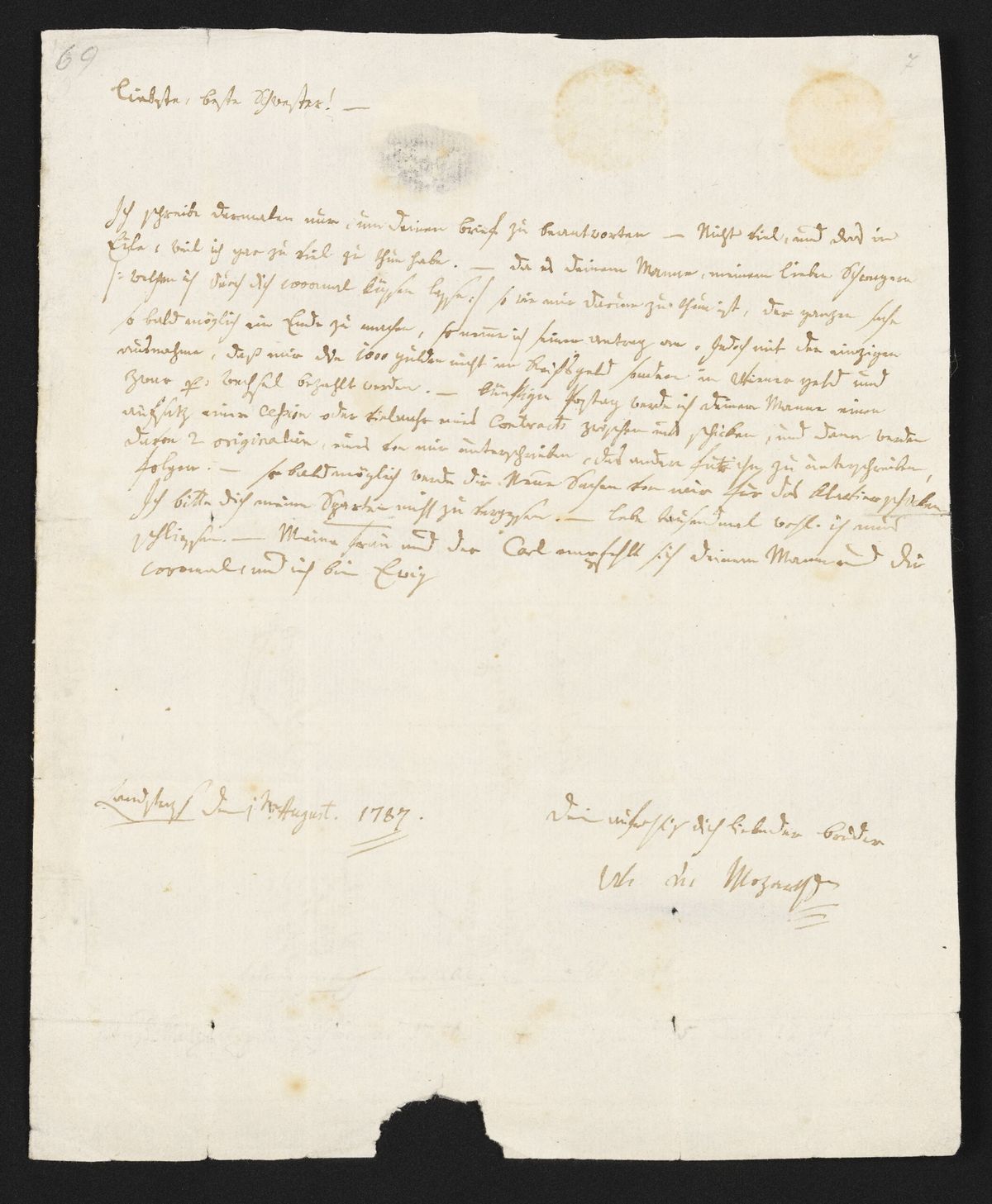
Eggers Collection
2005, is the most significant addition to the Mozarteum Foundation’s autograph collection since the donations made by Mozart’s two sons in the 19th century. It comprises a total of twelve high-ranking items: letters and documents belonging to the Mozart family, as well as handwritten musical scores by Leopold and Wolfgang Amadé Mozart. Most of these objects have never been shown in public before and are now being presented in an exhibition.
28 November 2025 – 1 February 2026, Mozart Residence
Mannheim, January 17, 1778
In a postscript to a letter of his mother, Mozart mentions Aloisia Weber for the first time, though without revealing her name. Mozart was captivated by the technical abilities of the then sixteen-year-old soprano. Shortly thereafter, Mozart began teaching her—and fell in love with her. However, his first love proved to be ill-fated, as Aloisia ultimately rejected him.
Vienna, February 15, 1783
Baroness Martha Elisabeth Waldstätten, born in 1744, was a close friend, champion, and generous supporter of Mozart and his wife. In this letter, Mozart urgently appeals to her for help in repaying a debt. His financial expectations from the sale of three piano concertos (KV 413–415) by subscription had not been fulfilled.
Vienna, February 10, 1784
During his final stay in Salzburg in late summer 1783, Mozart began a new opera, L’oca del Cairo, KV 422, with the Salzburg abbé and poet Giambattista Varesco. In this letter, he informs his father that he had to interrupt the composition due to more pressing commissions, and work on the opera was never resumed.
Frankfurt am Main, October 8, 1790
In the fall of 1790, Mozart traveled at his own expense to Frankfurt am Main, seeking to benefit from the vibrant cultural events surrounding the coronation of Emperor Leopold II. He regularly wrote to Constanze about his modest successes and his hope of earning enough to quickly repay his heavy debts.
Vienna, presumably late May 1791
Writing from Vienna, Mozart asked his friend Anton Stoll, organist and choirmaster in Baden, to return all the parts for his Mass in C major, KV 317—the so-called “Coronation” Mass—as he needed them for performances in the city. Mozart also requested Stoll’s help in finding a ground-floor apartment for his wife, Constanze, who was about to begin a six-week treatment at the baths during her pregnancy.
Salzburg, April 24, 1792.
When Mozart’s sister Maria Anna was asked to contribute to her brother’s biography after his death, she consulted a childhood friend, the court trumpeter Johann Andreas Schachtner, with some questions. He recorded for her, among other recollections, Some remarkable and wondrous things from his age of four to five, the veracity of which I could swear to.
Probably Salzburg, no later than November 24, 1799.
This curious document, in the hand of an unidentified scribe, is an invitation to join a men’s society in Salzburg. It was originally enclosed with a letter from Mozart’s sister Maria Anna, dated November 24, 1799, to the publisher Breitkopf & Härtel in Leipzig. Hans Joachim Eggers only possessed this letter for a short period of time, and the enclosure may have remained in his possession by chance.
Copy in Leopold Mozart’s handwriting, presumably Bologna, 1770
The Miserere in A minor, KV 85, survives only in a copy by Leopold Mozart. Wolfgang set Psalm 50 to music in 1770 in the style of Padre Giovanni Battista Martini, with whom he was studying in Bologna at the time. However, the copy breaks off at verse 16.
Autograph, Vienna, late 1785 or early 1786
The Masonic song Zerfließet heut, geliebte Brüder, KV 483, for cantor, male choir, and organ, was first performed—together with Ihr unsre neuen Leiter, KV 484, written on the verso of the same sheet—at the ceremonial opening of the Lodge Zur neugekrönten Hoffnung in Vienna on 14 January 1786.
Autograph (folios 2–3 containing mm. 23–62)
Vienna, October 19, 1782
Composed in 1782, Mozart’s second year in Vienna, the Concert Rondo in A major for Piano and Orchestra, KV 386, survives only in incomplete form. The manuscript’s first leaf was kept by a former owner, while the remaining pages—some intact, others cut into smaller fragments—were given away as souvenirs in the 19th century. Several of these pieces have since been lost.
Copy in Wolfgang Amadé Mozart’s handwriting, KV Anh. A 26 (formerly KV 91)
Vienna, ca. 1787—1788
This unusual manuscript contains the first 22 bars of a Kyrie by Georg Reutter the Younger, written in Mozart’s hand. Maximilian Stadler, who assisted Constanze Mozart in organizing her husband’s musical estate, regarded it as an unfinished original composition by Mozart and added thirteen bars in an effort to “complete” it.











